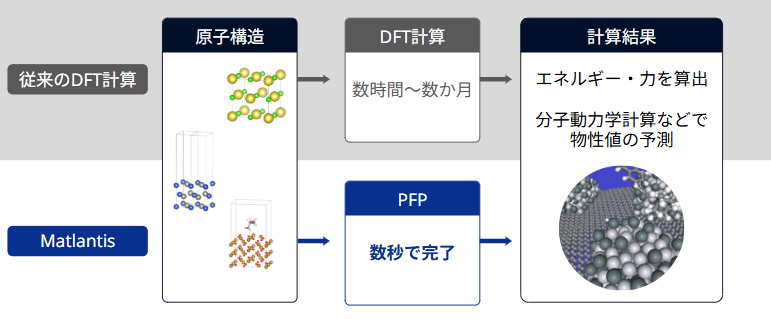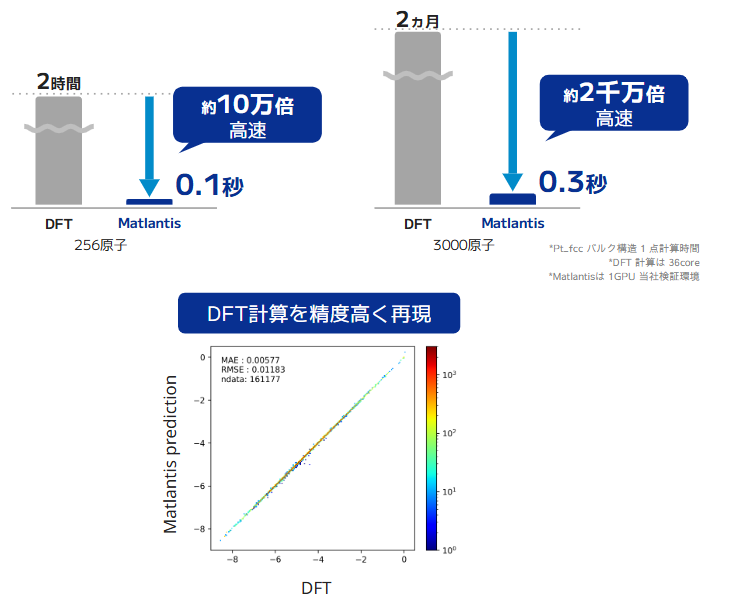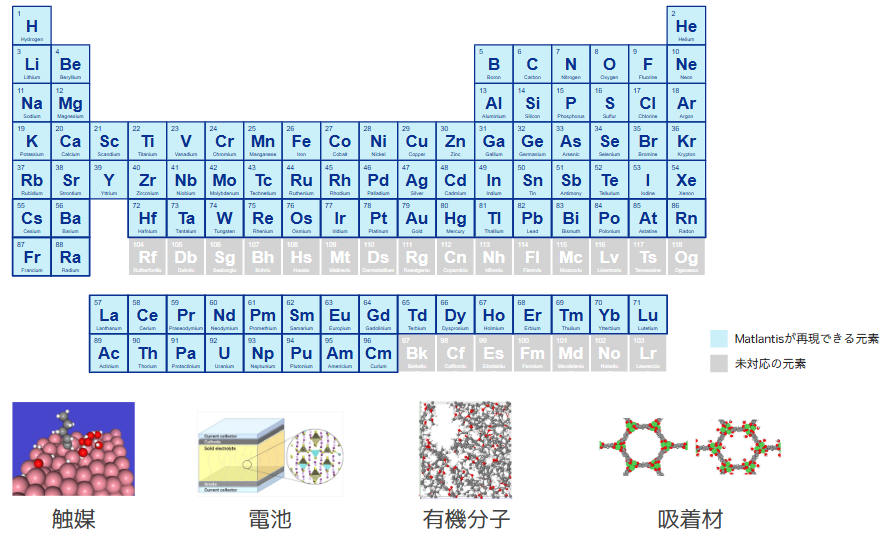What is our AI Model, PFP?
PFP (PreFerred Potential) is our proprietary AI model, developed by combining cutting-edge AI technology with deep expertise in materials science.
PFP: The World's First Truly Universal Machine Learning Potential
DFT-Level Accuracy at 20 Million Times the Speed
Supports 96 Elements, Covering the Entire Range of Naturally Occurring Elements
PFP: The World's First Truly Universal Machine Learning Potential
Density Functional Theory (DFT) is widely used to predict atomic behavior with high accuracy, but its computational cost remains a major bottleneck.
As a solution, machine learning interatomic potentials (MLIPs*) have emerged, where AI is trained to approximate DFT results. However, most existing MLIPs are tailored to specific materials or conditions, and developing a truly general-purpose model has long been considered extremely difficult.
At Matlantis, we took on this challenge from the early days of deep learning and developed PFP—our unique AI model offering world-class accuracy and versatility. The core technology behind PFP was also published in the journal Nature Communications.
Published paper: Towards universal neural network potential for material discovery applicable to arbitrary combination of 45 elements (Nature Communications, 2022)

DFT-Level Accuracy at 20 Million Times the Speed
PFP delivers prediction accuracy on par with DFT, while achieving computation speeds more than 20 million times faster.
Simulations that once took months on supercomputers can now be completed in minutes.
It also enables large-scale systems of up to 44,000 atoms* , allowing accurate simulations of complex interfaces and defect structures that were previously impractical.
By breaking through the limits of accuracy, speed, and scale, PFP is transforming the landscape of materials development.

Supports 96 Elements, Covering the Entire Range of Naturally Occurring Elements
PFP delivers exceptional versatility through a single AI model.
The 2024 release, PFP v7, supports 96 elements, covering the entire range of naturally occurring elements.
This eliminates the need for users to switch models or consider restrictions based on element types.
Moreover, its applicability goes far beyond bulk crystals. PFP can seamlessly and accurately simulate a wide variety of atomic structures and states—including catalytic reactions at surfaces and interfaces, ion diffusion in battery materials, decomposition of organic molecules, and adsorption in MOF composite materials—all within a single, unified model.

Architecture and Training Dataset
PFP’s performance is powered by an advanced AI architecture and a massive training dataset.
At its core, the model uses a graph neural network (GNN), which interprets atoms and their bonds as a graph.
This enables it to flexibly learn the local environment and interactions of individual atoms, allowing for highly accurate predictions even on previously unseen structures.
The training data comes from a wide variety of DFT calculations conducted on Preferred Networks’ computing platform.
These include not only stable structures but also unstable and non-equilibrium ones.
For PFP v7, over 59 million atomic structures were used in training.
This unprecedented scale and diversity of high-quality data is the foundation of PFP’s exceptional versatility.

PFVM: The Inference Engine That Accelerates Simulations
Matlantis's exceptional computational speed is achieved through the powerful synergy of two core components: the PFP AI model and the specialized software engineered to unleash its full potential.
At the core of this system is PFVM, a proprietary inference engine developed specifically for Matlantis. PFVM acts both as a compiler, optimizing PFP’s calculations using techniques such as kernel fusion, and as a runtime, executing those calculations efficiently on hardware with low memory usage.
By pairing the high-performance AI model PFP with the purpose-built PFVM engine, Matlantis delivers a simulation environment with speed and scalability unmatched by conventional approaches.
